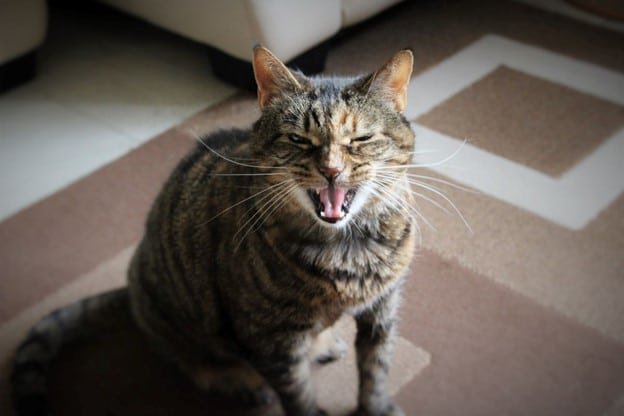Solutions for cat behavior issues can help them understand and manage their actions better. Let’s learn more about 7 common cat behavioral issues and solutions.
7 Common Cat Behavioral Issues and Solutions: In depth Cat Behavior Problem Analysis
Some cats might confuse or even frustrate their owners from time to time. For instance, because of scratching on the couch, excessive meowing, or cat fights, one will wonder whether the behavior is part of normal expectations at home. The behavior is nothing personal; it is merely intended to express or adapt and is not harmful to the owner. Figuring out cat behavioral issues may help enhance the furry friend and aid the interaction.
1. Common Cat Behavioral Issues
1.1. Aggressive Behavior Among Cats in the Home
When having more than two in the same home can result in constant fights and brawling. This is stressful for both the cats and their owners.

Why Does This Happen?
- Fighting Over Space: Cats want their own space. If they have to share beds, food, or favorite spots, they might get grumpy and start fighting.
- Not Enough Stuff: If there aren’t enough food bowls, litter boxes, or places to hide, cats may feel like they need to compete for what’s there.
- New Cats in the House: Well, a new cat can really upset the arrangement in a house and make all other old cats feel uncomfortable or unhappy.
How Can You Help?
- More Stuff for Each Family Member: Ensure that there are enough food bowls, litter boxes, and comfortable resting areas so that no cat should feel neglected.
- Time to Adjust: If you’ve brought home a new cat, keep it in a separate room at first. Show them each other through the doorway until they get acquainted with the smell before introducing them.
- Use Calming Products: Pheromone sprays and diffusers can also be helpful for calming your cats’ stress.
- Place of Safety: Ensure that each one has a quiet retreat somewhere where it can relax and feel secure.
By giving them what they need and by helping them into a new setting, you can make your home a happier place for everyone!
1.2. Aggression in Cats
Aggression directed at humans or other animals can be startling and potentially harmful.
Possible Causes:
- Fear or Anxiety: If your cat feels trapped or threatened, it will probably lash out.
- Pain or Illness: Cats with health problems will feel uncomfortable, so they become irritable and aggressive.
- Redirected Aggression: Cats see a stimulus outside their range, for example a cat outside the window. They react by getting angry.
Solutions:
- Identify and isolate your cat from things that make them anxious or fearful.
- Consult your veterinarian if you needed.
- Use interactive toys to redirect attention.
- Allow your cat time to cool down before approaching them.
You can try this interactive cat toys from amazon-
- [Trending Interactive Entertainment]: Potaroma’s new indoor cat toys provide an engaging, stimulating play experience fo…
- [Advanced Electronic Irregular Motion]: Powered by a smart motorized system, this electric cat toys deliver irregular mo…
- [Multi Modes for Indoor Fun]: Features a range of captivating movement modes that stimulate cat’s natural instincts to c…
1.3. Destructive Scratching
Cat scratching is normal. But bet no cat owner likes that. Furniture will be destroyed under the cat’s claws if you don’t find a way to stop it.
Possible Causes:
- Marking Territory: cats scratch for visual as well as scent marking.
- Exercise and Maintenance of Nails: Stretching muscles and sharpening claws through scratching.
- Boredom: Lack of stimulation causes boredom which may result in undesired scratching.
Solutions:
- Marking Territory: cats scratch for visual as well as scent marking.
- Exercise and Maintenance of Nails: Stretching muscles and sharpening claws through scratching.
- Boredom: Lack of stimulation causes boredom which may lead to unwanted scratching.

1.4. Litter Box Problems
The behavior of ineligible urination that occurs when the cat does not pee or poop in the litter box but outside it usually annoys the owners.

Possible Causes:
- Medical conditions: Such as urinary tract infection and bladder stones; also gastrointestinal disturbances.
- Litter box preference: Too dirty, too small, or badly located litter boxes can make them avoid all of these.
- Stress or anxiety: Changes in human occupants of the household, visitors with pets to which not all cats can adapt, or different situations may change the routine of the cat.
Solutions:
- Ascertain that a pet suffers from no acute medical problem by taking it to the vet.
- Keep the litter box clean and placed in a quiet, easy to reach.
- Provide multiple litter boxes in multi-cat household.
- Try a few varieties of litter in order to see which one your cat prefers.
You can try those good quality litter boxes from amazon. Those have very good quality and easy to clean. Also, pet will love it as different colors and easily reachable by pets.
- Great for High Peeing Cat: Reinforced plastic enclosure clasps firmly on the high sided stainless steel cat litter box, …
- Extra Large Stainless Steel Litter Box for Big Cats or Multiples: The XL litter pan is 23.6″ long by 16″ wide. Special d…
- Doesn’t Absorb Odor: Cleaning the high walled stainless steel litter box for cats is very easy as waste slides off the s…
1.5. Meowing and Yowling
Don’t ignore unusual or excessive meowing from your cat. It could be a sign your cat unwell. Refer to some causes and solutions.
Possible Causes:
- Attention-Seeking: Yowling may reflect boredom or the need for attention from the Owner.
- Health Problems: Hyperthyroidism or cognitive dysfunction in older cats.
- Hunger or Thirst: Meowing may indicate empty food or water bowls.
- Stress or Anxiety: Life changes can cause vocalization.
Solutions:
- Keep up the room: food and water intake as well as a clean litter box.
- Engaging cats in play with toys or climbing structures, as well as interactive play, will help eliminate boredom.
- Whoever wants to do some seeking has to wait. Don’t respond to excessive meows.
- Check with your vet if the behavior persists.

1.6. Behavior Issues In Older Cats
As cats old, they may undergo behavioral changes due to alterations in their body or brain.
Possible Causes:
- Cognitive Dysfunction Syndrome (CDS): Like getting demented, it can account for confusion and vocalization and for a certain change in behavior.
- Arthritis and Pain: Difficulties in moving about can cause one to stay afraid to find a litter box or change back to grumpy.
- Decreased Vision or Hearing: Decreased senses make the older cat more anxious or irritable.
Solutions:
- Provide accessible litter boxes and low-entry beds to accommodate physical limitations.
- Keep a consistent routine to reduce stress and confusion.
- Consult your vet about supplements or medications to manage pain or cognitive decline.
- Use nightlights to help cats with vision problems navigate in the dark.
1.7. Urine Marking in Cats
Urine marking is a common issue, especially in multi-cat households or after significant changes.
Possible Causes:
- Territorial Behavior: Cats mark to establish territory and communicate with other animals.
- Stress or Anxiety: Changes in the environment, such as new pets or moving, can trigger marking.
- Unspayed or Unneutered Cats: Hormonal influences make marking more likely.
Solutions:
- Spay or neuter your cat helps reduce hormone-driven marking.
- Clean marked areas thoroughly with enzymatic cleaners to remove scent traces.
- Provide plenty of vertical and horizontal spaces to reduce territorial disputes in multi-cat households.
- Minimize stress with calming aids and maintain a predictable routine.
2. Preventative Measures and Tips
While addressing cat behavioral issues is important; always keeping them avoid of stress, creates a happy living environment, which will keep them healthy.
- Catify the Environment: Enrich your home with toys, a climbing tree, and plenty of supervised interactive playtime.
- Safe Spaces: Having private, quiet areas available for a cat to go off alone for a time is essential during stressful times.
- Routine Vet Check-Ups: Regular health checks are always good to nip the trouble in the bud.
- Observe the Body Language and Behavior: Understanding the stressors or discomfort with a cat involves being observant.
- Positive Reinforcement: Rewarding treatment, affection, and praise will encourage the behaviors you would like to see repeated.

3. Conclusion
Cat behavioral issues are often quite difficult to handle. However, when one understands why they occur, it is possible to assist. Imagine trying to be patient with, and kind to your feline companion. This will enhance their life, and yours as well. In many cases, you will be there to manage your temper, provide relaxation, and create pathways for more natural behavior. A little effort can make your home peaceful for both of you.






